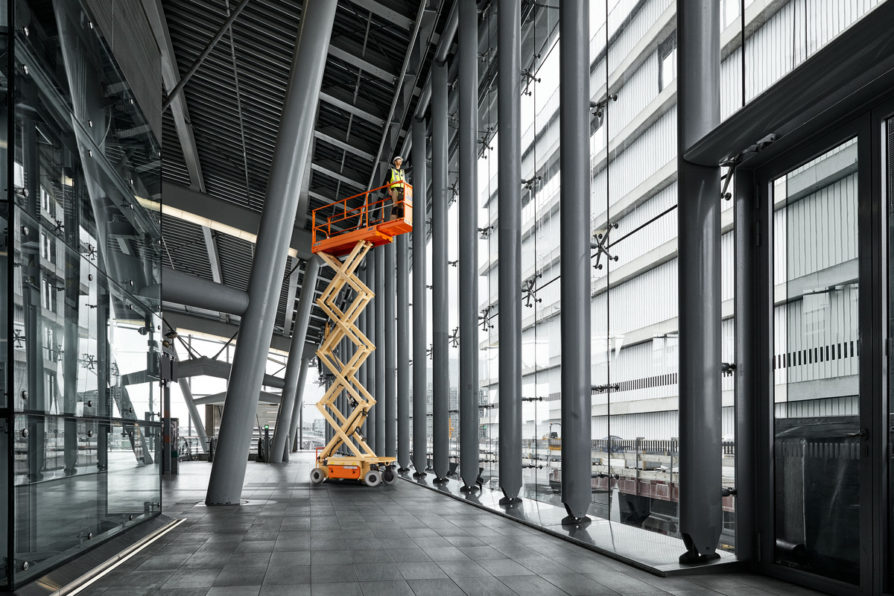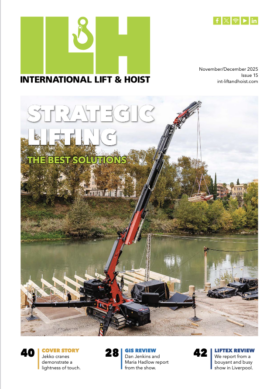)
A very good year?
After a global pandemic and supply chain volatility, what does 2023 hold for the MEWP industry? Dan Jenkins talks to manufacturers full of optimism for the coming months.
Despite some strong headwinds, MEWP manufacturers still grew sales in 2022 and are gearing up for more growth this year. So, what is driving their predictions and what other trends will shape the MEWP market in 2023?
Global growth
“For 2023, the market may exceed for the first time in its history more than 400,000 units a year,” says Haulotte marketing director Christophe Lacaze. However, there remains some debate as to whether the USA remains the world’s biggest buyer of access equipment – it depends on whether you measure it by volume or value. “For the second year in a row, China is the first market in the world by volume,” adds Lacaze. “For 2023, China is expected to remain the first market worldwide, following by the United States which still remain the first market if we consider the market in value.”
Genie recently gave its thoughts on global growth in a presentation to Terex Corp investors. Simon Meester, president of Genie, says, “We have one of the widest, deepest broadest portfolios in the industry and that is why there is so much upside for our product because there are still immature markets that haven’t even started adopting our products.
“We have done a lot of cost-out, a lot of process improvement, we are a lot more agile in the way we operate. We have been investing in the expansion of our footprint. Our new product development is only going to ramp up in the next couple of years. The future is very bright in terms of demand for our products. We will always continue to push the envelope and push ourselves.
“We are very optimistic about our outlook we see significant upside. First of all, it is straight up fleet growth. Secondly it is really an amplified replacement cycle. So, our industry has been constrained in the last couple of years and as such our customers were forced to age their fleets. We are still constrained today so it is going to take some time for the industry to come back to more historical trends of where fleet age sits typically.
“The third variable is adoption. China has grown exponentially and now we also see markets – large economies like India, Indonesia and Argentina – start to adopt our products.”
Skyjack also expects to see substantial global growth. “Market numbers show that we are at or approaching pre-pandemic levels in 2022,” says Malcolm Early, Skyjack’s VP of marketing. “While market levels remain high, we are aware that supply chain issues have also played a role in pulling back growth as demand exceeded supply in 2022. Had it been otherwise there may well have been additional growth.
“Looking to 2023, there is talk of inflationary pressures and an approaching recession. However, recent rental industry reports have highlighted that the industry is placed to cope well. Supply chain issues has meant that the rental industry’s moves to reduce fleet aging, experienced during the pandemic, have not been fully satisfied. So, while the economy may feel some pressure, the MEWP market will most likely see sustained demand.”
The regional picture
“While these factors play out globally, North America is best placed for growth,” adds Early. “In Europe, concerns over Ukraine and consequent energy costs may mean demand growth suffers in comparison. However, there will still be growth.
“In Asia the market is dominated in volume terms by China, and we have seen some demand reduction as the zero Covid policy hit many areas. The announcement of relaxation may be welcome by the population, although the rise in cases means it’s a little early to tell if China will now experience some of the issues Europe and North America have gone through as the pandemic played out. In general terms China may see some muted growth in demand, but one must remember it is at fairly high levels.”
Genie estimates that emerging markets represent an opportunity worth USD 1 billion, with a focus on bigger economies such as India and Indonesia where working at height practices are changing.
In a recent investor presentation, JLG owner Oshkosh shared data that North American MEWP rental fleet average age is typically 50 months but has been extended to 60 months. Bringing this back down to normal levels will require additional investment.
Industrial markets
The industrial and manufacturing sectors represent circa 20% of the total global market. Genie estimates the appetite for MEWPs in the industrial and manufacturing sectors as USD 3 billion out of a total addressable market of USD 15 billion.
Xavier Deshors, business intelligence analyst for Haulotte, says, “The industrial maintenance sector will continue to drive a high demand for MEWPs, as all industries are driven by a strong demand, high backlogs and need to use MEWPs in their daily business for maintenance concerns. In addition, more stringent regulation to avoid also ladders and podiums accelerates the demand for MEWPs in all industrial sectors and in most developed countries.”
Maintenance is also driving sales of low-level access according to Skyjack. “In the field of maintenance, we have seen low level access grow, whether it be for vertical mast or micro scissor type products,” says Early. “Equally, the increase on connectivity globally has seen a growth in data centre construction which again favours the low-level access segment.”
Skyjack is also recognising the ongoing opportunities provided by the exponential growth of the logistics sector, as more consumers switch to online retail and home shopping. “As one drives on the highway one cannot help seeing the increase in warehouse development,” adds Early. “That development has increased through the pandemic as online shopping grew. These buildings have high, steel skeletons with cladded exteriors and this will drive both boom and rough terrain scissor demand.”
Increasing capacity
One of the biggest challenges for MEWP manufacturers in recent years has been supply chain constraints which have acted as a drag on growth.
John C. Pfeifer, president and chief executive officer of JLG owner Oshkosh Corporation recently told investors, “We continue to improve supply chain resiliency through a combination of dual and alternate sourcing actions as well as technical redesign of some components, which we expect will help us strengthen our performance.”
Haulotte expects supply chain constraints to continue this year. “2023 will still experience supply chains constraints, due to global demand which will remain at a high level and the China market booming,” adds Deshors.
As Skyjack’s Early points out, it was impossible to see the supply chain issues coming. “Of course, the very nature of many of these shortages was their unexpected nature, so it’s a brave person who makes too many forecasts here,” he says. “As we worked through the pandemic and the subsequent shortages it became necessary to look at our supply chain structure and indeed our manufacturing footprint.
“For Skyjack, outside of the pandemic, we have been reaching capacity in our existing plants. During 2022 we spent a lot of time and energy on improving the vertical integration of existing facilities and expanding our global footprint and developing local, shorter supply chains. We will look to see the benefits of that programme in 2023 and beyond.”
Skyjack has just announced the opening of a new facility in Mexico. Based in Ramos Arizpe in the state of Coahuila, the 200,000sq ft factory is now home to production of Skyjack telehandlers and boom lifts, while the company’s Canadian plants focus on scissors and vertical mast lifts.
Skyjack is already working on phase two of the Ramos Arizpe facility which will take it to 690,000sqft and is expected to be completed by the third quarter of this year.
Genie is also creating a 1 million sqft factory in Monterrey, Mexico. “We think we will push our first products out in late second quarter 2023,” says Meester. “It is not just a copy-paste of our manufacturing footprint; it is actually a facility that is going to take us to the next level of manufacturing excellence and where we think manufacturing needs to be in the next five years.”
Sustainability
When it comes to trends, Terex sees one megatrend that is driving all others. John Garrison, Chairman and CEO of Terex Corp told investors, “The centre of that megatrend is sustainability. We fundamentally have to change the way in which we operate around the world. What else does that drive? If we look at electrification and net zero that is substantial investment required to achieve the net zero objectives that people have set out.”
This was echoed by Meester who added, “We want to make sure we keep leading the market in electrification. At the moment around 70% per of our portfolio is electrified…expect to see more from us in terms of electrification in terms of hybrid solutions and in terms of digital solutions.”
Most manufacturers are in agreement that increasing the number of electric and hybrid products is a main priority. “Of course, electrification of diesel equipment will continue to drive the product development of the main manufacturers,” says Haulotte’s Lacaze. “We will see in access sector more and more product using Lithium batteries solutions, and perhaps see the first hydrogen concept on bigger machines.”
JLG sees electrification as an ongoing major driver. A JLG spokesperson says, “Industry-wide, interest in electric products is rapidly increasing due to continued pressure to find more non-fossil fuel-based solutions. We expect to see demand for these types of machines continue to gain popularity as battery technology advances and environmental considerations become more and more stringent.
“To address this, JLG continues to work on projects that will add more electrified solutions and model options to our robust portfolio of electrified products.
Where machines were already electric, such as slab scissors and vertical masts, the trend remains switching from hydraulic to direct drive systems. “In recent years there has been an increase of interest in direct electric drive as a replacement for hydraulic systems for slab machines,” says Skyjack’s Early. “For Skyjack the popularity of that option on our vertical mast product has been welcome and we will look to extend that to other product lines.”
Other key trends
JLG expects more from technologies such as robotics. “Advances in technology also carry huge potential for safety and productivity improvements,” says a spokesperson. “From using smart robotic arms to complete repetitive to operating machines fitted with detection sensors it’s all about keeping people, places and things protected and productive throughout every project.
“Other trends customers will expect in MEWPs soon are increased job site connectivity and more moments of autonomy. New tools and solutions are being used to create ‘moments of autonomy’ with aerial equipment, continuing to advance the connected job sites of today and build the smart cities of the future. With applications like AR and mobile control apps, and in other instances, we are now seeing the integration of robotics with MEWPs. While these innovations won’t replace humans, they might be used to complete repetitive tasks in particularly hazardous environments where we don’t want to put people.”
Haulotte agrees that robotics is an emerging trend for MEWP operations. “Will see also more and more new robotic applications using the machine remotely for cleaning, sanding, drilling, glass lifting and so forth,” says Deshors. “Moreover, the benefits of telematics solutions are being recognized in the rental sector and adoption is increasing.”
Skyjack also thinks there is more to come from this technology. “The real focus is on gaining more from telematics,” says Early. “There is still much runway to be explored so that companies better utilise data and work to lessen machine downtime using remote diagnostics and troubleshooting.”
JLG sees telematics as a standard part of MEWP fleet management now. “The use of telematics to manage fleet operations has become the new normal. By providing information on machine systems from every angle, including immediate diagnostics, telematics has significantly reduced costly and lengthy repair calls and improved real-time communication between the OEMs and equipment owners, service technicians and end users.
“As this technology continues to evolve, it might be time for the conversation to change from talking about telematics and talking about internet of things (IoT). IoT will further improve visibility and performance into the health of a machine by accessing so much more than the data regarding location, usage and fuel, for simple, flexible and informed proactive fleet management.”











